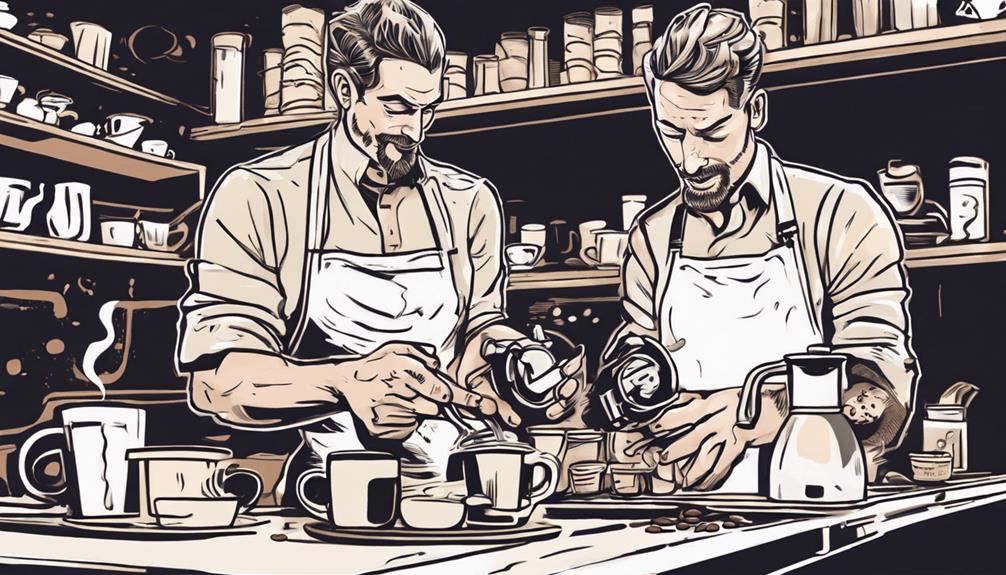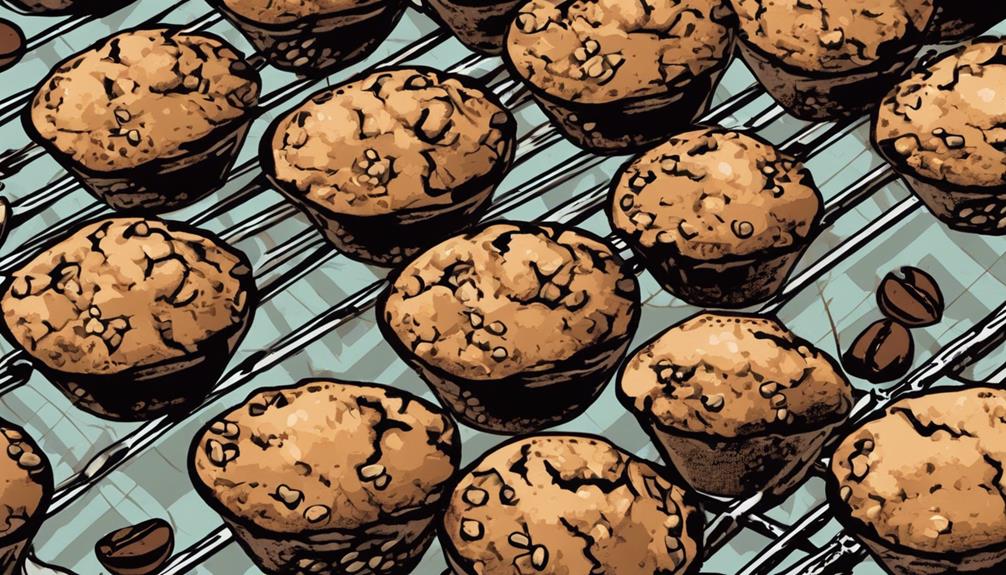Dive deep into the world of coffee expertise to transform into a true coffee wizard. Learn the secrets of brewing the perfect cup, mastering latte art, and honing your espresso-making skills. Understand key elements such as water temperature, grind size, and milk frothing techniques. Experiment with different grind sizes for unique flavors and flawless latte art for visual appeal. Embrace the path to becoming a coffee connoisseur through rigorous training and practice. Ready to elevate your coffee skills? Discover the art of coffee mastery and take your brewing abilities to the next level.
Key Takeaways
- Rigorous training in coffee knowledge and practical techniques.
- Focus on espresso making skills and mastering latte art.
- Participation in specialized coffee mastery programs.
- Emphasis on milk steaming, equipment maintenance, and experimentation.
- Positive feedback and recommendations from seasoned enthusiasts.
Coffee Master Program Overview
If you're passionate about coffee and aspire to become a Coffee Master, understanding the program overview is essential to your journey.
The Coffee Master program at Starbucks is designed to recognize expertise in coffee knowledge through rigorous training and assessments. This program, established over 20 years ago, aims to celebrate Starbucks partners who excel in their coffee expertise. Current Coffee Masters proudly retain certifications and wear black aprons, symbolizing their high level of coffee mastery.
To be eligible for the prestigious Black, Coffee Master Apron, Starbucks partners must complete levels 100-300 of courses and have over 1 year of experience at Starbucks. Coffee Masters aren't just knowledgeable about coffee regions and flavors but are also skilled in crafting beverages and sharing their expertise with customers.
Becoming a Certified Coffee Specialist
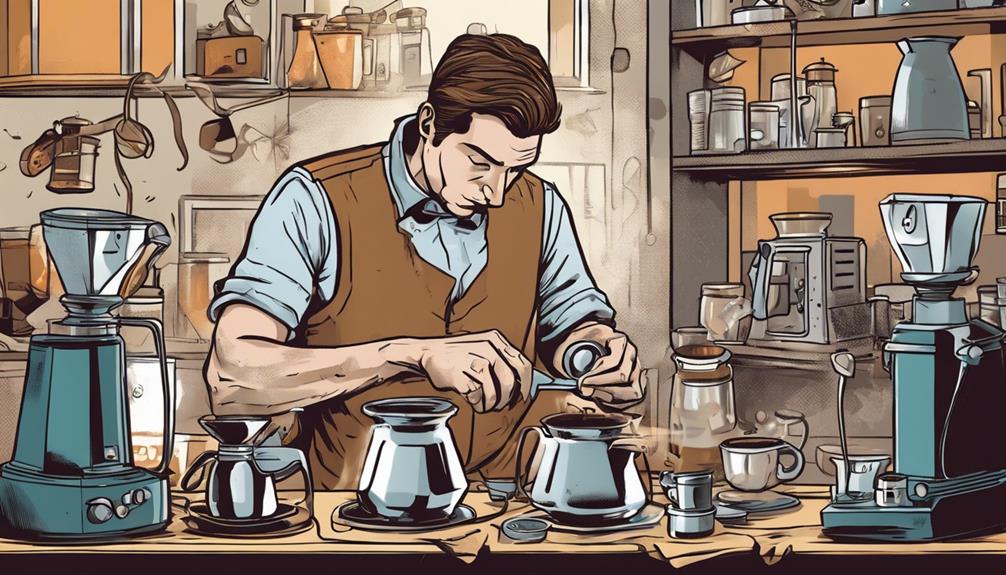
To advance your journey towards becoming a Coffee Master, consider enrolling in the Certified Coffee Specialist program offered by Masters of Coffee. This Level I certification is available for enrollment at $595 and serves as the foundation for aspiring Coffee Masters globally. Endorsed by esteemed authorities in the coffee industry, this certification provides a professional-level endorsement that is internationally recognized and respected. Participants in this program gain foundational knowledge and practical competence in the field of coffee, setting a high standard for expertise.
| Certified Coffee Specialist Program | Details |
|---|---|
| Certification Level | Level I |
| Enrollment Fee | $595 |
| Launch of Master of Coffee Program | 2024 |
The Certified Coffee Specialist program is the stepping stone towards achieving higher levels of mastery, with the Master of Coffee program, Level II certification, set to launch in 2024. By enrolling in this program, you are taking a significant step towards honing your skills and knowledge in the world of coffee.
Practical Coffee Brewing Techniques

Mastering practical coffee brewing techniques involves understanding key factors such as water temperature, brewing time, grind size, tamping, pre-infusion, milk steaming, and equipment maintenance.
As a Coffee Master, you must grasp the importance of water temperature and brewing time for best coffee extraction. Experiment with different grind sizes to explore how they impact flavor and extraction rates, fine-tuning your technique to perfection.
Perfect your tamping and pre-infusion skills to create the ideal espresso shot that embodies balance and complexity. Practice milk steaming until you achieve the desired texture for crafting exquisite latte art, adding a visual element to your coffee creations.
Elevating Espresso Making Skills

How can you enhance your espresso making skills to create exceptional shots every time?
Elevating espresso making skills involves mastering various techniques like tamping, pre-infusion, and flow profiling. Understanding the unique requirements of your espresso machine regarding extraction, temperature, and pressure is essential for consistent quality. Additionally, perfecting latte art is a key aspect of elevating your espresso game, requiring dedication to practicing and achieving the ideal milk texture.
To truly excel in making espresso, you must grasp the importance of factors such as grinding, water quality, and equipment maintenance. The impact of these elements on the final taste of your espresso can't be underestimated.
Perfecting Latte Art
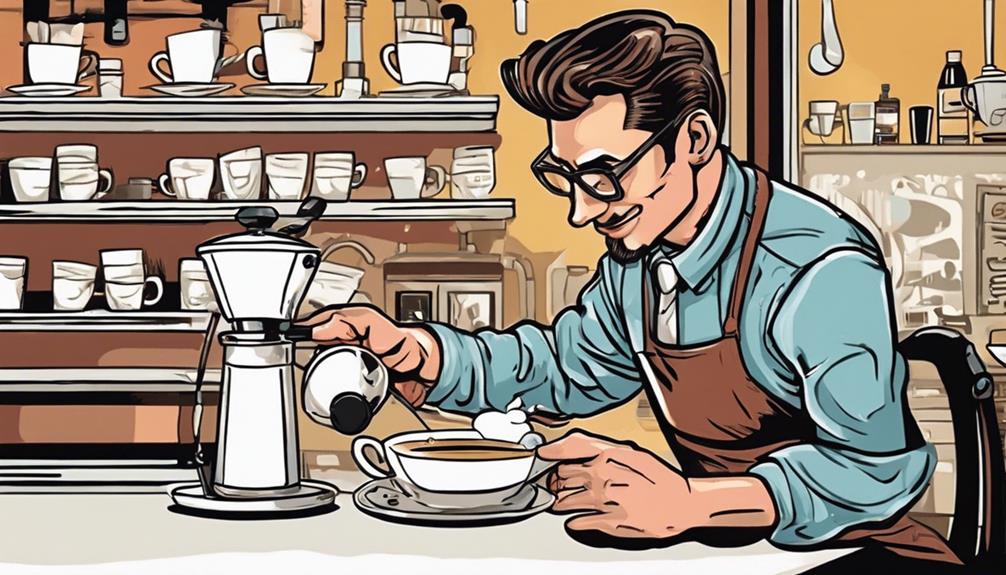
Improve your coffee presentation skills by mastering the art of latte designs through honing milk texturing techniques. Latte art is a vital component of coffee education and adds a visually appealing element to your beverages.
To excel in this art form, focus on achieving the ideal milk consistency by properly steaming it. Different jug designs can influence the outcome of your latte art creations, so experiment with various styles to find what works best for you.
Patience, practice, and attention to detail are essential for perfecting latte art. Take the time to refine your pouring technique and develop your creativity in creating intricate designs. The process may require several attempts, but the results are gratifying.
Importance of Equipment Maintenance

To maintain the quality and hygiene standards necessary for your coffee-making efforts, proper equipment maintenance is essential.
As a Coffee Expert, you understand the importance of regularly cleaning your coffee-making equipment. Hygiene practices are crucial for upholding professional standards in coffee preparation.
Depending on your equipment usage, the frequency of cleaning is key to prevent contamination and maintain the freshness of your brews.
By implementing proper maintenance routines, you make sure that you can consistently deliver exceptional coffee experiences to your customers.
Cleanliness plays a fundamental role in equipment maintenance, helping you prevent off-flavors and prolong the longevity of your tools.
Event Details and Registration

Join us at 2801 21st Ave. S in Minneapolis, MN on May 25th, 2024, from 10am-12pm for an interactive event focused on enhancing your home coffee brewing skills. Become a coffee master by mastering the art of brewing with us in a small group setting limited to 10 attendees, ensuring personalized attention and a hands-on learning experience.
During the event, enjoy complimentary coffee drinks and take home a 12 oz bag of Peace Coffee to continue practicing your newfound skills.
To secure your spot, register early as classes are subject to cancellation three days prior to the event if minimum enrollment isn't met. In case of cancellation, you'll have the option to rebook for a future session or receive a full refund.
Don't miss this opportunity to immerse yourself in the world of coffee brewing and elevate your home barista game. Sign up now to start on your journey towards becoming a coffee master!
Shipping Information for Participants
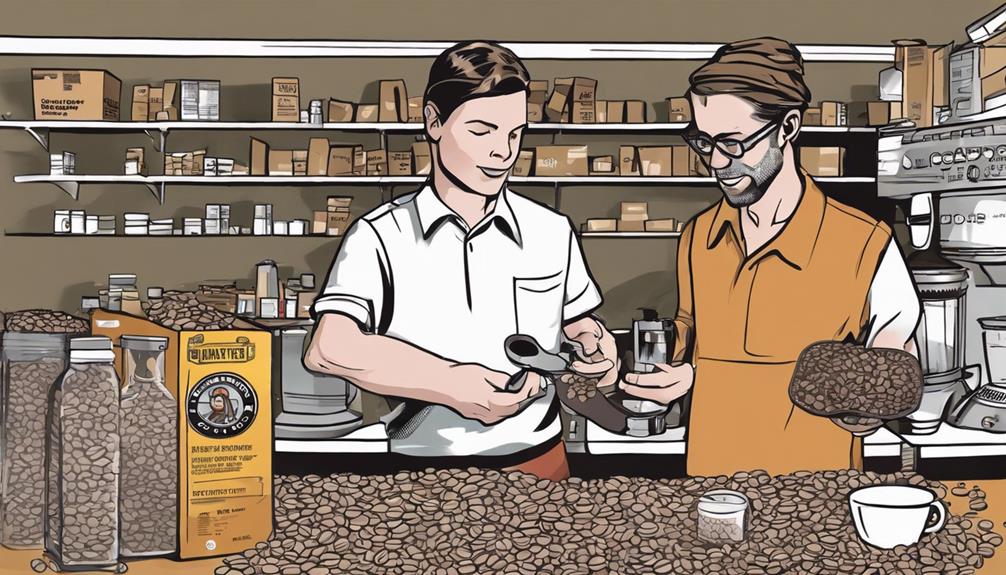
Participants can anticipate their orders to be shipped within 3 business days, with weekend orders processed on Mondays.
Once your order is on its way, you'll receive email notifications to keep you updated about the shipping status.
Standard shipping is available at a cost of $5, but if your order total exceeds $40, you qualify for free shipping. However, please be mindful that certain shipping restrictions may apply to specific locations.
If you have any concerns about shipping to your area, it's recommended to reach out to customer service for clarification.
Remember, in case of any shipping inquiries, you'll need to provide confirmation of your purchase as proof of your order.
Customer Review and Feedback

As you journey through the customer reviews and feedback section, you'll uncover valuable insights shared by participants of the coffee master class. Their testimonials provide firsthand experiences and practical tips to enhance your coffee-making skills at home.
Gain valuable knowledge and recommendations from those who've already started on this flavorful journey.
Customer Testimonials
Customers have praised the Coffee Master class with a perfect 5-star rating for its insightful content and beginner-friendly approach. Participants found the class to be a valuable resource in mastering the art of making good coffee at home. The practical tips shared during the sessions were particularly lauded for their effectiveness in enhancing home brewing techniques. Past attendees highly recommend the class to anyone seeking to elevate their coffee brewing skills, emphasizing the focus on delivering implementable tips without requiring additional equipment.
Feedback from customers underscores the class's ability to break down complex coffee concepts into easy-to-understand lessons, making it accessible for beginners and seasoned enthusiasts alike. The positive testimonials highlight the class's hands-on approach, empowering participants to apply their newfound knowledge immediately.
Experience Sharing
Feedback from attendees unanimously praised the Coffee Master class as an invaluable resource for honing coffee brewing skills, particularly emphasizing its beginner-friendly approach. Customers rated the class 5 out of 5 stars, indicating high satisfaction with the content and delivery. Many found the class to be fantastic and beneficial for those new to the world of coffee. Participants appreciated the well-explained process of making good coffee and were impressed by the practical tips provided to enhance their home brewing skills effectively. One past participant even highly recommended the class to others looking to improve their coffee brewing abilities.
| Feedback Highlights | Customer Ratings | Recommendation |
|---|---|---|
| Fantastic for Beginners | 5/5 Stars | Highly Recommended |
Participant Insights
Participant feedback from the Coffee Master class highlighted the practical tips provided for enhancing home brewing skills without the need for additional equipment. Customers appreciated the class, rating it 5 out of 5 stars and noting its fantastic content, especially suitable for beginners.
The class effectively explained the process of making good coffee, improving participants' coffee knowledge. Past attendees highly recommend the class for those seeking to enhance their coffee brewing skills.
Registrants can anticipate a focus on improving home coffee brewing, addressing bitterness and strength in coffee, and creating delicious coffee regardless of the brewing method used. This feedback underscores the class's effectiveness in imparting valuable coffee knowledge and practical tips for elevating home brewing skills without requiring additional equipment.
If you're looking to enhance your coffee brewing abilities and understanding, this class comes highly recommended by those who've experienced its benefits firsthand.
Mastering Coffee: Final Thoughts

As you conclude your journey towards mastering coffee, reflect on the knowledge and skills you have acquired through the rigorous Masters of Coffee program. By successfully completing the Certified Coffee Specialist (CCS) program, you took the first step towards becoming a Coffee Master. This certification laid the foundation for your advanced studies, leading you to pursue the prestigious Master of Coffee (MC) program launching in 2024. Through these internationally recognized programs, endorsed by respected authorities in the coffee industry, you have honed your expertise to a professional level.
The educational opportunities provided by the Masters of Coffee program haven't only equipped you with theoretical knowledge but also practical competence in the art of coffee. As you navigate the challenges and opportunities presented by the Coronavirus pandemic, your dedication to mastering coffee shines through.
Embrace the final thoughts of your journey, knowing that you have developed the skills and expertise needed to excel in the dynamic world of coffee.
Frequently Asked Questions
How Can I Become a Coffee Expert?
To become a coffee expert, you should consider enrolling in a certified program like the Certified Coffee Specialist (CCS) to kickstart your journey. The upcoming Master of Coffee (MC) program in 2024 sets a high standard for aspiring coffee connoisseurs.
What Is a Certified Coffee Master?
To become a certified Coffee Master, you must master all aspects of coffee – sourcing, roasting, blending, and brewing. Through rigorous training and assessments, you earn the title and black apron as an expert in creating and sharing coffee knowledge.
How Many Starbucks Coffee Masters Are There?
There are over 30,000 Starbucks Coffee Masters globally. They are known for their coffee expertise and wear black aprons. Through rigorous training and assessments, they guide customers to their perfect coffee experience.
How to Get the Coffee Master Apron?
To get the Coffee Master Apron at Starbucks, you need to complete levels 100-300 of the Coffee Academy. With over a year of Starbucks experience and a manager's approval, the black apron recognizes your coffee expertise and achievement.
Conclusion
Congratulations on taking the first step towards becoming a coffee master! With dedication and practice, you'll soon be brewing up the perfect cup every time. Upgrade your knowledge of different coffee beans and brewing methods, experiment with different ratios, and take the time to really savor the flavors. And remember, don’t be afraid to master the coffee shop challenge and try your hand at creating latte art or mastering the art of the perfect espresso shot. With determination and passion, you’ll be well on your way to becoming a true coffee connoisseur.
So grab your favorite beans, fire up your espresso machine, and let your creativity flow as you perfect your latte art skills.
The journey to mastering coffee may be challenging, but the delicious results are more than worth it. Keep brewing, and enjoy every sip along the way!
